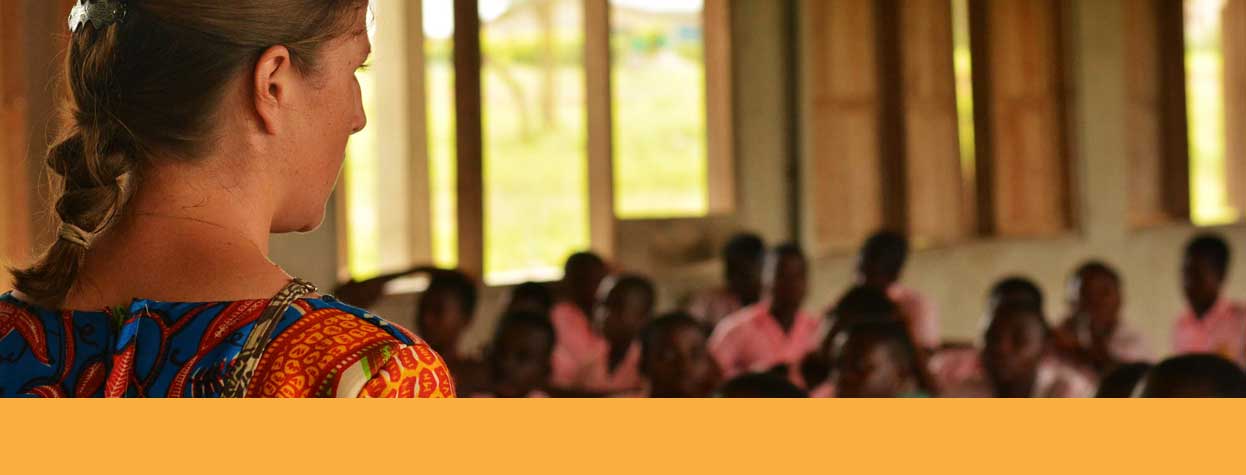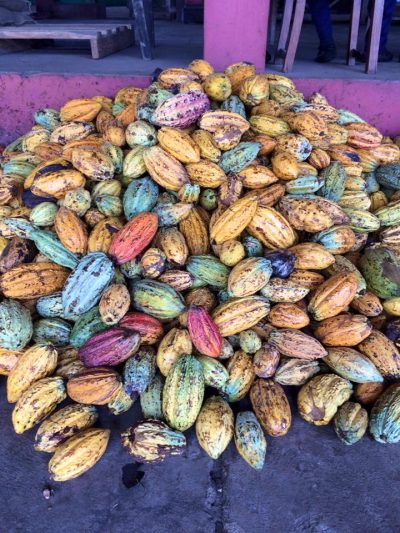- Fan Products
In Ghana, where milk and mostly all milk products besides chocolate are a delicacy, Fan Products are a friendly reminder of home to us AgriCorps Fellows. In the sweltering heat of Sub-Saharan Africa, a Fan Product comes in handy like popsicles on a hot summer July day in the States. Whether you like chocolate, yogurt, ice cream, or orange juice, almost everyone will find a favorite Fan Product. My personal favorite is FanChoco, which is the equivalent of a frozen chocolate milk. Most of my students love FanYogo. It can be compared to a frozen Yoplait Strawberry flavored Go-Gurt. FanIce is quite the sweet treat if you have a hankering for something like soft-serve vanilla ice cream. Occasionally an AgriCorps Fellow can be found putting FanIce on a pancake or a slice of apple pie at Thanksgiving!
- Ghanaian Fabric
The wild prints, beautiful bold colors, and exotic shapes and figures that make up African Fabric are absolutely gorgeous to the dull browns, blues, and black solids of my American wardrobe. I’ll admit, I own a few Vineyard Vines, Southern Tide, or Lily Pulitzer pieces, but the majority of what we wear in America is simple, but classy. However, Ghanaians dress to impress and make a statement. And if your like me, then you secretly take pictures of women’s dresses when their not looking so you can show your seamstress you want this style of dress made just for you! All of us  Fellows have had trousers, shirts, dresses, skirts, vests, and we could have almost anything made because seamstresses and tailors are very talented here. Buying Ghanaian Fabric can be a little bit addicting because it’s so cheap and so BEAUTIFUL! Plus, the locals really love to see obruni’s in “African Wear.” It serves as a sign of respect and appreciation for their country’s culture. We even have our own AgriCorps fabric. I plan on having an apron made from all my scrap pieces of fabric, because let’s be honest these beautiful dresses won’t fit forever!
Fellows have had trousers, shirts, dresses, skirts, vests, and we could have almost anything made because seamstresses and tailors are very talented here. Buying Ghanaian Fabric can be a little bit addicting because it’s so cheap and so BEAUTIFUL! Plus, the locals really love to see obruni’s in “African Wear.” It serves as a sign of respect and appreciation for their country’s culture. We even have our own AgriCorps fabric. I plan on having an apron made from all my scrap pieces of fabric, because let’s be honest these beautiful dresses won’t fit forever!
- Bowl Fruit
Fried Dough, that’s exactly what Bowl Fruit its. Baked balls of bread, then deep fried. And oh, s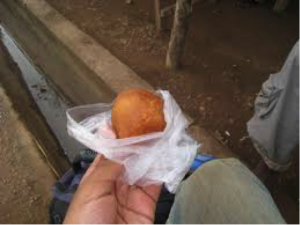 o good. I’m from the south, so I’ve fried a lot of things in my life, and everyone has been to the county and state fairs where the vendors sell almost anything fried, but never have I had something so good as bowl fruit. Typically, in America I would shy away from something so “unhealthy,” but let’s think about this, when walking is my main form of transportation in the village, I think I can afford to consume a ball of fried dough. This savory snack also can be found sold on the tops of market ladies heads just about anywhere.
o good. I’m from the south, so I’ve fried a lot of things in my life, and everyone has been to the county and state fairs where the vendors sell almost anything fried, but never have I had something so good as bowl fruit. Typically, in America I would shy away from something so “unhealthy,” but let’s think about this, when walking is my main form of transportation in the village, I think I can afford to consume a ball of fried dough. This savory snack also can be found sold on the tops of market ladies heads just about anywhere.
- Sobolo
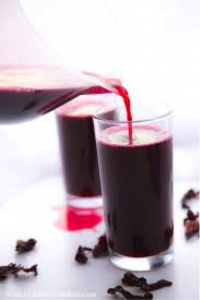 Or it’s literal term, Hibiscus Tea. This fruity, gingery, and refreshing drink is made from dried hibiscus flowers, sugar, spices, ginger, and sometimes crafters add a few special ingredients. It’s typically homemade, bottled, and sold on the heads of market ladies. After soaking the dried leaves of the hibiscus overnight in water the flavor is extracted, then you boil, and add sugar and other ingredients. This drink can be served hot or cold. It tastes like a mixture of grape and cranberry juice with a little kick of spice. Madame Cecelia, my fellow teacher makes and sells it to the children at school. A couple times a week I will help her pour the sweet liquid into the bags and tie them up to be put in the freezer. Whenever I’m really tired and need a pick me up, I buy a sachet of sobolo from her.
Or it’s literal term, Hibiscus Tea. This fruity, gingery, and refreshing drink is made from dried hibiscus flowers, sugar, spices, ginger, and sometimes crafters add a few special ingredients. It’s typically homemade, bottled, and sold on the heads of market ladies. After soaking the dried leaves of the hibiscus overnight in water the flavor is extracted, then you boil, and add sugar and other ingredients. This drink can be served hot or cold. It tastes like a mixture of grape and cranberry juice with a little kick of spice. Madame Cecelia, my fellow teacher makes and sells it to the children at school. A couple times a week I will help her pour the sweet liquid into the bags and tie them up to be put in the freezer. Whenever I’m really tired and need a pick me up, I buy a sachet of sobolo from her.
- Red Red
This local Ghanaian dish quickly became a favorite for us AgriCorps Fellows (once we were finally 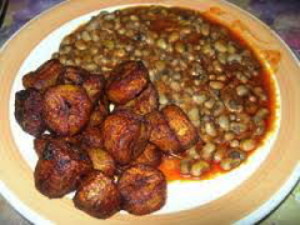 adventurous enough to try and eat something besides chicken and rice). The dish consists of stewed cowpeas (they taste just like black eyed peas), fried plantains, sometimes white rice, and any meat of your choice, such as chicken, fish, guinea fowl, goat, you get the idea. I think we like it so much because Americans are use to variety. In America we are use to eating multiple things on our plates at one time for a meal, whereas here in Ghana, most dishes are some sort of stew eaten with some sort of carb. Also, the red red is just really flavorful and filling!
adventurous enough to try and eat something besides chicken and rice). The dish consists of stewed cowpeas (they taste just like black eyed peas), fried plantains, sometimes white rice, and any meat of your choice, such as chicken, fish, guinea fowl, goat, you get the idea. I think we like it so much because Americans are use to variety. In America we are use to eating multiple things on our plates at one time for a meal, whereas here in Ghana, most dishes are some sort of stew eaten with some sort of carb. Also, the red red is just really flavorful and filling!
- Groundnut Paste
In the Northern Region of Ghana, where it’s drier and has more of flat, savanna style landscape, groundnuts are grown in mass quantities. Groundnuts are the equivalent of what we know as peanuts. I  guess Ghanaians are just really matter of fact, since they do grow in the ground, why not call them groundnuts. Peanut Butter is obviously popular in America, so I’m sure it’s no surprise we have come to love the Ghanaian equivalency! If you’ve ever had the brand Smucker’s Natural Peanut Butter, that’s what groundnut paste reminds me of. There’s not much added to the groundnut paste besides the groundnuts, so there is a small small amount of natural oil separation when it’s made into paste. Ghanaians mostly use groundnut paste for groundnut soup, and it’s so good!
guess Ghanaians are just really matter of fact, since they do grow in the ground, why not call them groundnuts. Peanut Butter is obviously popular in America, so I’m sure it’s no surprise we have come to love the Ghanaian equivalency! If you’ve ever had the brand Smucker’s Natural Peanut Butter, that’s what groundnut paste reminds me of. There’s not much added to the groundnut paste besides the groundnuts, so there is a small small amount of natural oil separation when it’s made into paste. Ghanaians mostly use groundnut paste for groundnut soup, and it’s so good!
- Balls of Carbs
As I stated earlier, almost all dishes in Ghana are a form of soup or stew and a balls of carbs. What I mean by balls of carbs is, where us Americans might sit down to a dinner of “meat and potatoes,” their carbs are formed into balls. You break some off and dip it into the stew or soup. The most popular balls of carbs are Fufu, Banku, Kenke, and Rice Balls. Fufu is made of boiled cassava and yam then pounded into a dough like ball structure. Banku and Kenke are both fermented maize, they are prepared differently, but both made into balls. Rice balls are just mashed rice made into balls. All of these may sound terrible to you reading this right now, but trust me after living here a while you will come to enjoy these dishes and look forward to eating them. Possibly, even prepare them yourself!
- Milo or Chocolim
Very similar to Hot Chocolate, Milo is taken mostly at breakfast as an alternative to coffee or tea. I prefer the brand Chocolim, just because I think it’s a little sweeter. Milo is advertised to have lots of nutritious vitamins and healthy things for kids and adults who would probably lack nutrients such as calcium in their diet. They even have Milo energy cubes!
- Ghanaian Chocolate
During our month of in-country training in August, we visited the Cocoa Research Institute and learned all 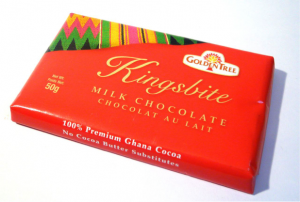 about the production of a top commodity in Ghana: cocoa. We also bought some chocolate and wow, was it amazing! The dark chocolate was actually my favorite. Something interesting about the production of cocoa trees in Ghana: cocoa use to be a major commodity in Ghana, but competitors such as Coté de Ivore became a threat to the Ghanaian cocoa market, so the government of Ghana started COCOBOD. They grow seedlings and give them to registered farmers to encourage production in Ghana. They also grow and give away the trees which are planted in between cocoa trees to provide shade, they give the farmers fertilizer, and whatever else is needed to be a successful cocoa farmer. It’s really a great way for a farmer to start a business. All the farmer has to do is prepare the land and haul the seedlings to be planted. Eighteen months later the hybrid seedlings will have become large trees that have produced beautiful pods of cocoa! These trees last on average 20-25 years. Something we get to do as AgriCorps Fellows is be a “dot connector” and help introduce farmers to the nearest COCOBOD to sign up to receive seedlings!
about the production of a top commodity in Ghana: cocoa. We also bought some chocolate and wow, was it amazing! The dark chocolate was actually my favorite. Something interesting about the production of cocoa trees in Ghana: cocoa use to be a major commodity in Ghana, but competitors such as Coté de Ivore became a threat to the Ghanaian cocoa market, so the government of Ghana started COCOBOD. They grow seedlings and give them to registered farmers to encourage production in Ghana. They also grow and give away the trees which are planted in between cocoa trees to provide shade, they give the farmers fertilizer, and whatever else is needed to be a successful cocoa farmer. It’s really a great way for a farmer to start a business. All the farmer has to do is prepare the land and haul the seedlings to be planted. Eighteen months later the hybrid seedlings will have become large trees that have produced beautiful pods of cocoa! These trees last on average 20-25 years. Something we get to do as AgriCorps Fellows is be a “dot connector” and help introduce farmers to the nearest COCOBOD to sign up to receive seedlings!
- Water Sachets
It’s hot in Ghana and thank goodness the market ladies sell “pure water” because they are a cool drink on a warm day! Most everyone in Ghana drinks water out of sachets. Us AgriCorps Fellows have nice large 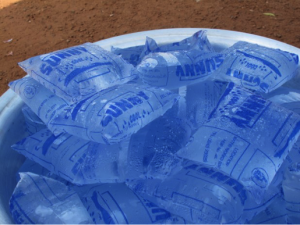 water filters in our village that allows us to filter well water for drinking, but if were on the go or out and about we always buy sachets. To drink the water out of the bag you bite a corner of the bag off with your teeth to create a hole in the bag and enjoy! Their 500 mL only cost 20 peswas which is equivalent to about 4 pennies. If you buy a sleeve which is about 20 sachets, it cost anywhere from 2.20 cedi to 4 cedi. (4 cedi=$1) As you can see these are really cheap!
water filters in our village that allows us to filter well water for drinking, but if were on the go or out and about we always buy sachets. To drink the water out of the bag you bite a corner of the bag off with your teeth to create a hole in the bag and enjoy! Their 500 mL only cost 20 peswas which is equivalent to about 4 pennies. If you buy a sleeve which is about 20 sachets, it cost anywhere from 2.20 cedi to 4 cedi. (4 cedi=$1) As you can see these are really cheap!
Emma Cannon received a bachelor’s degree in Agriculture Science from North Carolina State University. Before becoming an AgriCorps Fellow Emma served as a state FFA President.

